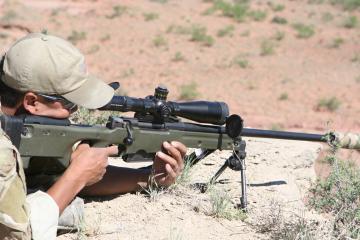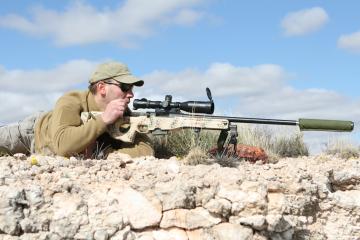Originally published in 2009 Tactical Operator magazine

 Practical long-range rifle shooting is about making first-round hits on targets to the effective
range of the rifle, in the field and under time pressure.
Over the last five years, interest in practical long-range shooting has bloomed. This type of
long-range shooting involves making first-round hits on arbitrary-distance long-range targets while
moving through the field using the best shooting positions available in the terrain. In contrast to
conventional competition formats, there is no set course of fire: the idea is to use the available
geography to set up a unique challenge for the long-range shooter. The application of these skills
to both sporting and military is obvious.
Competitions in this format are split between describing themselves as "tactical" matches and
"hunters test" matches. Examples include Dr. David Kahn's Keneyathlon, the Practical Rifle Team
Challenge (CO), the NRA Whittington Center's Sporting Rifle Match (NM), the Blue Steel Ranch Steel
Safari (NM), and various "Sniper Challenge" matches around the country such as the Nor-Cal Tactical
Bolt Rifle Challenge held at the Sacramento Valley Shooting Center. Whatever the name, the crux is
delivering first-round hits on unknown-distance targets. With off-the-shelf rifles available for
under a grand that will hold one-MOA groups, half the equipment problem is easily solved. The other
big decision regards optics.

 For a brief moment while running the bolt, the author looks over the scope to orient the rifle on
the next target in a field challenge.
Besides giving a magnified view of the target and providing a sight picture, the scope is the
instrument used to specify the elevation and windage corrections that are critical to making
long-range hits.
What optics should you put on your long-range rifle? A scope for practical long-range shooting
needs to do the following: provide a clear view of the target area and a precise-enough sight
picture; precisely specify hold-over out to the maximum engagement distance; precisely specify wind
drift or target lead or trail out to the maximum engagement distance; and allow optical ranging of
targets when a laser range-finder cannot be used. The adjustments need to be 100-percent repeatable; the
scope needs to retain zero. Low-light capability is desirable.
When you pick up a scope, the first thing you do is look through it, put the reticle on target
and get a sight picture. In variable-magnification scopes, there are two types of reticles: first
focal-plane (FFP) and second focal-plane (SFP). Most shooters are used to SFP reticles that appear
to stay the "same size" as the magnification is turned up and down. Paradoxically, this means that
at different magnification settings, the reticle features demarcate different angular distances.
For example, if the mil-dots are calibrated at 10x, then at 5x, they would actually mark 2 mils.
Confusing? It sure is, and that leads us to the solution: the first focal-plane reticle.
The FFP reticle appears to "shrink" as the magnification is dialed down, just as
the actual target image shrinks. This constant ratio means that the reticle features are always
calibrated; 1 mil is always 1 mil regardless of scope power. The shooter can use the reticle for
range estimation, elevation hold-over, and windage hold-off at any magnification setting. The
downside of the FFP configuration is that the reticle lines can be too fine at low magnification and
too thick at high magnification.
|